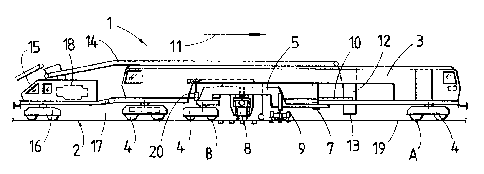Une partie des informations de ce site Web a été fournie par des sources externes. Le gouvernement du Canada n'assume aucune responsabilité concernant la précision, l'actualité ou la fiabilité des informations fournies par les sources externes. Les utilisateurs qui désirent employer cette information devraient consulter directement la source des informations. Le contenu fourni par les sources externes n'est pas assujetti aux exigences sur les langues officielles, la protection des renseignements personnels et l'accessibilité.
L'apparition de différences dans le texte et l'image des Revendications et de l'Abrégé dépend du moment auquel le document est publié. Les textes des Revendications et de l'Abrégé sont affichés :
| (12) Brevet: | (11) CA 2350166 |
|---|---|
| (54) Titre français: | TECHNIQUE ET MACHINE POUR LE BOURRAGE D'UN RAIL |
| (54) Titre anglais: | A METHOD AND MACHINE FOR TAMPING A TRACK |
| Statut: | Périmé et au-delà du délai pour l’annulation |
| (51) Classification internationale des brevets (CIB): |
|
|---|---|
| (72) Inventeurs : |
|
| (73) Titulaires : |
|
| (71) Demandeurs : |
|
| (74) Agent: | RICHES, MCKENZIE & HERBERT LLP |
| (74) Co-agent: | |
| (45) Délivré: | 2005-08-09 |
| (22) Date de dépôt: | 2001-06-08 |
| (41) Mise à la disponibilité du public: | 2001-12-09 |
| Requête d'examen: | 2002-04-10 |
| Licence disponible: | S.O. |
| Cédé au domaine public: | S.O. |
| (25) Langue des documents déposés: | Anglais |
| Traité de coopération en matière de brevets (PCT): | Non |
|---|
| (30) Données de priorité de la demande: | ||||||
|---|---|---|---|---|---|---|
|
Une section de soulèvement de rail (19), délimitée par deux boggies (4), d'une machine (1) de bourrage d'un rail est allongée dans la direction longitudinale du rail dans une première passe pour soulever le rail et placer un ballast sous le rail 2. Au cours d'une passe ultérieure visant à obtenir la position désirée finale et à bourrer le rail (2), la section de soulèvement de rail (19) est raccourcie.
A track lifting section (19), delimited by two rail undercarriages (4), of a machine (1) for tamping a track is extended in the longitudinal direction of the track in a first working pass for lifting the track and introducing ballast underneath the track 2. In a further working pass for producing the final desired position and for tamping the track (2), the track lifting section (19) is shortened.
Note : Les revendications sont présentées dans la langue officielle dans laquelle elles ont été soumises.
Note : Les descriptions sont présentées dans la langue officielle dans laquelle elles ont été soumises.

2024-08-01 : Dans le cadre de la transition vers les Brevets de nouvelle génération (BNG), la base de données sur les brevets canadiens (BDBC) contient désormais un Historique d'événement plus détaillé, qui reproduit le Journal des événements de notre nouvelle solution interne.
Veuillez noter que les événements débutant par « Inactive : » se réfèrent à des événements qui ne sont plus utilisés dans notre nouvelle solution interne.
Pour une meilleure compréhension de l'état de la demande ou brevet qui figure sur cette page, la rubrique Mise en garde , et les descriptions de Brevet , Historique d'événement , Taxes périodiques et Historique des paiements devraient être consultées.
| Description | Date |
|---|---|
| Le délai pour l'annulation est expiré | 2018-06-08 |
| Lettre envoyée | 2017-06-08 |
| Accordé par délivrance | 2005-08-09 |
| Inactive : Page couverture publiée | 2005-08-08 |
| Inactive : Taxe finale reçue | 2005-05-25 |
| Préoctroi | 2005-05-25 |
| Un avis d'acceptation est envoyé | 2005-05-05 |
| Lettre envoyée | 2005-05-05 |
| Un avis d'acceptation est envoyé | 2005-05-05 |
| Inactive : Approuvée aux fins d'acceptation (AFA) | 2005-04-05 |
| Modification reçue - modification volontaire | 2004-11-24 |
| Inactive : Dem. de l'examinateur par.30(2) Règles | 2004-08-04 |
| Lettre envoyée | 2002-05-13 |
| Requête d'examen reçue | 2002-04-10 |
| Exigences pour une requête d'examen - jugée conforme | 2002-04-10 |
| Toutes les exigences pour l'examen - jugée conforme | 2002-04-10 |
| Demande publiée (accessible au public) | 2001-12-09 |
| Inactive : Page couverture publiée | 2001-12-09 |
| Inactive : CIB en 1re position | 2001-08-09 |
| Inactive : Certificat de dépôt - Sans RE (Anglais) | 2001-07-11 |
| Lettre envoyée | 2001-07-11 |
| Demande reçue - nationale ordinaire | 2001-07-11 |
Il n'y a pas d'historique d'abandonnement
Le dernier paiement a été reçu le 2005-04-15
Avis : Si le paiement en totalité n'a pas été reçu au plus tard à la date indiquée, une taxe supplémentaire peut être imposée, soit une des taxes suivantes :
Les taxes sur les brevets sont ajustées au 1er janvier de chaque année. Les montants ci-dessus sont les montants actuels s'ils sont reçus au plus tard le 31 décembre de l'année en cours.
Veuillez vous référer à la page web des
taxes sur les brevets
de l'OPIC pour voir tous les montants actuels des taxes.
Les titulaires actuels et antérieures au dossier sont affichés en ordre alphabétique.
| Titulaires actuels au dossier |
|---|
| FRANZ PLASSER BAHNBAUMASCHINEN-INDUSTRIEGESELLSCHAFT M.B.H. |
| Titulaires antérieures au dossier |
|---|
| HERBERT WORGOTTER |
| JOSEF THEURER |